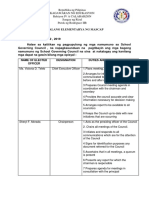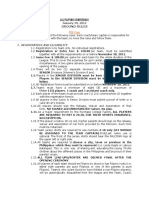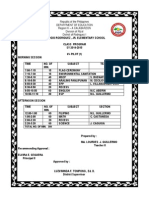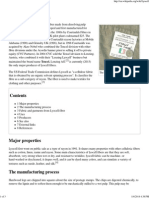Science LP New
Science LP New
Uploaded by
Ma Victoria Dumapay TelebCopyright:
Available Formats
Science LP New
Science LP New
Uploaded by
Ma Victoria Dumapay TelebOriginal Title
Copyright
Available Formats
Share this document
Did you find this document useful?
Is this content inappropriate?
Copyright:
Available Formats
Science LP New
Science LP New
Uploaded by
Ma Victoria Dumapay TelebCopyright:
Available Formats
Tuesay Science V-Iron I. II.
9:50 10:50
July 2,2013
Construct a model to demonstrate the mechanism of breathing A. The Respiratory system B. Science Idea : A lung model enables you to understand the mechanism of breathing better C. Science Processes : describing , demonstrating, inferring D. Materials : Clear plastic , cylindrical bottle , plastic , Y tube , modeling clay , small ice candy bag , big rubber balloon , rubber band , adhesive tape , scissors , screw driver E. References : BEC V , I 4.2 Into the Future : Science and Health 5 , pp. 22-23 F. Values : Resourcefulness and self-awareness
III.
Procedure: A. Review : What are the parts of the respiratory system? Describe the function of each B. Lesson Proper : 1. Motivation You have learned about the different organs of the respiratory system. Do you want to have a clear view of the different parts thru a model and how your respiratory organs work? 2. Presentation : To understand the mechanism of breathing , let us construct a lung model 3. Developmental activities a. Distribute the activity chart b. Each group prepare their materials for the construction of a lung model 4. Activity Proper Pupils will work on their activity to construct a lung model based on the steps indicated in the activity chart. 5. Post activity Discussion : a. Record the answer to the question on the board b. Explain briefly the process involved using the lung chest model 6. Generalization: What happens when you push the balloon? Pull the balloon? How do these movements affect the plastic bag? 7. Application : When one suffers from asthma or a fractured rib , is the breathing affected? How? Why?
IV.
Evaluation : Explain briefly the mechanism of breathing using the lung , chest model have constructed. Write your explanation in one sentence. Assignment : Using your lung-chest model , trace the path of air as it moves in the different parts of the respiratory system.
V.
V- Iron 5 4 3 Total
Wednesday Science V-Iron I. II. 9:50 10:50
July 3,2013
III.
Infer that some common ailments of the respiratory system are caused by pollution, smoking or inhaling drugs. A. Common ailments of the respiratory system B.Science Ideas : The different organs of the respiratory system are susceptible to ailments such as common colds, sore throat , emphysema and bronchitis Discomforts brought about by these ailments can be relieved by rest , medication or intake of fluids. C. Science Processes : observing , describing D. Materials : chart E. References : BEC V 1.5.5.1.5.2 Into the Future : Science and Health 5 Tx. Pp. 25-27 F. Values : Health Awareness A. Review Trace the path of air and what happens to it in the different parts of the respiratory system B. Lesson Proper : 1. Motivation : Have you ever been sick with respiratory ailments? How about the other members of you family? Can you name some of these ailments? Do you know how to treat these diseases? 2. Presentation : I want you to be familiar with the different ailments of the respiratory system as well as its causes, symptoms, prevention and treatment. Youll know more of these in our lesson today. 3. Development of the lesson : a. Present the table to the class b. Discussion : 1. Vocabulary development : symptoms, prevention , treatment 2. What causes some of the common ailments of the respiratory system? 3. Explain the cause/s , symptoms, prevention and treatment of each of the common ailments of the respiratory system 4. Generalization What are the common ailments affecting the respiratory system? Describe the causes, symptoms, prevention and treatment of these ailments. How can you be relieved of the discomforts brought about by these ailment. 5. Application : You are sick of fever or one another of your family is sick of fever, what you do to relieve him/her of the ailment?
IV.
Evaluation : DIRECTION : Choose the letter of the best answer. 1. Most of the ailments of the respiratory system are caused by _______. a. Lack of rest and sleep c. bacteria and virus b. Not eating a balanced diet d. allergies 2. An ailment which is caused by allergy to drugs or substances which trigger allergic reactions. a. Bronchitis c. emphysema b. Tonsillitis d. asthma 3. The symptoms of this ailment is shortness of breath , distended chest coughing with phlegm. a. Emphysema c. pneumonia b. Asthma d. bronchitis 4. ______ is an ailment which can be treated by gargling with warm water avoiding talking too much. a. Pulmonary tuberculosis c. throat infection b. Common colds d. tonsillitis 5. Discomforts brought about by ailments can be relieved by ________. I. Rest II. Medication III. Intake of liquids a. I b. II c. III d. I,II,III
V.
Assignment : Bring to the class tomorrow cardboards for your placards/flash cards or cigarette box , pentel pen , sticks and thumb tacks
V- Iron 5 4 3 Total
Thursday Science V-Iron I. II. 9:50 10:50
July 4,2013
Practice good health habits to keep the respiratory system healthy A. Good health habits for your Respiratory system B. Science Ideas : There are different ways of keeping our respiratory system healthy such as staying in a clean environment and practicing good health habits. C. Science Process: inferring, describing , communicating D. References : BEC V,I.6.6.1 Exploring Science and Health 6 TX p. 31 E. Materials : placards, flashcards F. Values : Health awareness A. Review what are the common ailments of the respiratory system? B. Lesson Proper 1. Motivation Have you heard about the saying Health is wealth? Explain this sentence. 2. Presentation Today, lets discuss the good health habits to keep our respiratory system through a health campaign to be presented by the diff. grps. 3. Developmental Activities a. Vocabulary development : health habits b. Recall the standards to follow for being a good speaker and a great listener. c. Pupils get their activity cards. d. Activity Proper e. Post activity discussion 4. Generalization What are the good health habits that you should do to keep your respiratory system healthy? 5.Application If you live in a very dusty and smoky place near factories and busy streets. You will breathe in dust and harmful chemicals , smoke and fumes, what should you do?
III.
IV.Evaluation DIRECTIONS : True of False. 1. Drink eight to ten glasses of water everyday. 2. Eat a balanced diet. 3. Avoid harmful substances like smoking. 4. Take a bath everyday. 5. Engage in outdoor exercise daily.
V.Asssignment: Interview your mother. Ask her how she takes care of you when you are sick of fever.
V- Iron 5 4 3 TOTAL
Friday Science V-Iron 9:50 10:50
July 5,2013
I. II. III.
Answer test question with 75% mastery level. Weekly test A. Reading the guidelines in taking a test B. Giving the test questions C. Reading the directions D. Answering the test questions IV. Checking / Recording
Monday Science V-Iron I. II. 9:50 10:50
July 8,2013
III.
Describe the structure and function of the urinary system. A. Urinary System B. Science Ideas : The urinary system is composed of organs that remove waste materials from the blood stream. These organs include the kidney, urinary bladder and urethra and ureters. C. Science processes : describing , inferring , observing D. Materials : chart , picture of the urinary system E. References : BEC V 1.7.7.1 Into the Future : Science and Health 5 TX F. Values : Self-awareness A. Preparatory Activity : Word puzzle ; arrange the jumbled letters into a correct word which has a meaning given opposite it. Enos where carbon dioxide exhaled Arlge estiesnint- where solid waste passes Insk where perspiration gets out of the body Yendik helsp getting rid of dirty water from the body B. Lesson Proper : 1. Motivation You learned in your lesson on digestive system that a part of the food taken by the body ends up as waste. You also learned that the carbon dioxide that you exhale is also a waste product. Do you know that the dirty water in your body is also a waste? 2. Presentation : Today , youll learn how this dirty water be excreted from your body through the urinary system. 3. Developmental Activity: a. vocabulary development : urine b. leaders get their activity chart. c. activity proper d. post activity Discussion : recording / reporting of answers to questions in the activity charts. 4. Generalization: Describe the structure of the urinary system? What is the function of the urinary system? What are the different major parts of the urinary system? 5.Application : During the night time you feel urinating. But you are afraid to get up and urinate because it is very dark. Is it advisable for you to wait until morning to urinate? Why?
IV.
Evaluation Direction : Fill in the blank correct answer. 1. ______ is composed of organs that remove waste materials from the blood stream. 2. ______ is the organ of the urinary system where urine is found. 3. ______ is a muscular structure found in the lower abdomen which temporarily holds the urine. 4. _____ is a muscular tube which carries off urine from the bladder. 5. _____ is another muscular tube which carries waste from the kidney to the bladder. Assignment Interview a health worker, nurse or doctor on how urine is formed and eliminated from the body.
V.
V- IRON 5 4 3 TOTAL
You might also like
- GRADE 5 SCIENCE Lesson Plan - CompilationDocument100 pagesGRADE 5 SCIENCE Lesson Plan - CompilationMa Victoria Dumapay Teleb86% (401)
- GRADE 5 SCIENCE Lesson Plan - CompilationDocument100 pagesGRADE 5 SCIENCE Lesson Plan - CompilationMa Victoria Dumapay Teleb86% (401)
- SGC Resolusyon BLG 2Document4 pagesSGC Resolusyon BLG 2Ma Victoria Dumapay Teleb93% (29)
- Guide To Datacenter Modernization Through Azure Stack HCI 1Document30 pagesGuide To Datacenter Modernization Through Azure Stack HCI 1ShubhamNo ratings yet
- L&D Qatame FrameworkDocument23 pagesL&D Qatame FrameworkMa Victoria Dumapay Teleb81% (21)
- S 06 - Wosm and The BSP StructureDocument68 pagesS 06 - Wosm and The BSP StructureMaravilla JayNo ratings yet
- Class Program Grade 3Document9 pagesClass Program Grade 3Salvation IsraelNo ratings yet
- Phil IRI FormsDocument7 pagesPhil IRI FormsLawrence Patrick Ladia LimenNo ratings yet
- L10 Steps in Constructing Teacher Made Tests Item Analysis Test DevelopmentDocument62 pagesL10 Steps in Constructing Teacher Made Tests Item Analysis Test DevelopmentkateaubreydemavivasNo ratings yet
- SsesDocument11 pagesSsesNell Tagulao-EclipseNo ratings yet
- Individual Assessment Forms1Document9 pagesIndividual Assessment Forms1Maria Ivz ElborNo ratings yet
- MID YEAR ASSESSMENT Checklist Feb 6 72023 EditedDocument3 pagesMID YEAR ASSESSMENT Checklist Feb 6 72023 Editedronnie100% (1)
- SCIENCE Elem. Matrix For The Learning Continuity PlanDocument7 pagesSCIENCE Elem. Matrix For The Learning Continuity PlanThe Great Papyrus100% (1)
- Body Structures of Animals For Adaptation and Survival 2nd Grading Week 3Document33 pagesBody Structures of Animals For Adaptation and Survival 2nd Grading Week 3daitoNo ratings yet
- Project All Numerates: Mia Gail B. Samaniego AdviserDocument8 pagesProject All Numerates: Mia Gail B. Samaniego AdviserMia Gail SamaniegoNo ratings yet
- GPP 2022-2023 PPT EditedDocument215 pagesGPP 2022-2023 PPT EditedEdimar RingorNo ratings yet
- Individual Learning Monitoring Plan: Division of Davao CityDocument21 pagesIndividual Learning Monitoring Plan: Division of Davao CityMarry Grace MoriteNo ratings yet
- Annex 1a School Forms Checking Report 1 13Document3 pagesAnnex 1a School Forms Checking Report 1 13Romel GarciaNo ratings yet
- Ang Mga Bayawak Sa Bundok Mantalingahan - Single PageDocument40 pagesAng Mga Bayawak Sa Bundok Mantalingahan - Single PageRabang Hydee Lyn GraceNo ratings yet
- Socio/ Academic/ Anecdotal Record: Dipaculao Central SchoolDocument3 pagesSocio/ Academic/ Anecdotal Record: Dipaculao Central SchoolSarahMostolesBambalanNo ratings yet
- Classroom Reading Inventory in Egra Phil IriDocument5 pagesClassroom Reading Inventory in Egra Phil IriMelieza Melody AmpanNo ratings yet
- Monitoring FormDocument4 pagesMonitoring FormdechavezvidalNo ratings yet
- Learning Area Learning Task: Quarter Iv: Learner'S Packet (Leap) - Pivot 4ADocument8 pagesLearning Area Learning Task: Quarter Iv: Learner'S Packet (Leap) - Pivot 4AKristel Joy DalisayNo ratings yet
- Final PPTX EGRA ScoringDocument20 pagesFinal PPTX EGRA Scoringmylane.casinayNo ratings yet
- Department of Education: Detailed Lesson Plan in Epp/Tle 6 Home EconomicsDocument11 pagesDepartment of Education: Detailed Lesson Plan in Epp/Tle 6 Home EconomicsBea Claresse TarapeNo ratings yet
- Matatag Class ProgramDocument8 pagesMatatag Class ProgramMARIA TERESA RIVERA100% (1)
- Orientation LPDocument9 pagesOrientation LPlivy malayoNo ratings yet
- Automated Grading Sheet 2017-2018 by Ronald C. TanedoDocument25 pagesAutomated Grading Sheet 2017-2018 by Ronald C. TanedoJM ReynanciaNo ratings yet
- DLL - SCIENCE Grade 5Document8 pagesDLL - SCIENCE Grade 5Donald Dann BuhayanNo ratings yet
- RPMS Tool For T I IIIDocument78 pagesRPMS Tool For T I IIIMaria Jobelle Borja AlbiaNo ratings yet
- Girl Scout of The PhilippinesDocument3 pagesGirl Scout of The PhilippinesAlgie RegañonNo ratings yet
- DLP in Math 420190620-58548-11gki9mDocument11 pagesDLP in Math 420190620-58548-11gki9mJohannah AlinorNo ratings yet
- LP Science Week 2Document5 pagesLP Science Week 2ropNo ratings yet
- RPMS - Grade 5 - VIERNES, RHODADocument66 pagesRPMS - Grade 5 - VIERNES, RHODARhoda ViernesNo ratings yet
- Science 5 Cot 4th QuaterDocument4 pagesScience 5 Cot 4th QuaterRachelle PedroNo ratings yet
- Reading Assessment Tool in English For Elementary (Grades 4 - 6)Document9 pagesReading Assessment Tool in English For Elementary (Grades 4 - 6)nana caracasNo ratings yet
- DLL Matatag - Math 4 Q1 W3Document10 pagesDLL Matatag - Math 4 Q1 W3JONATHAN VILLANUEVANo ratings yet
- Inset Attendance Sheet: Mapula-Pula Elementary School S.Y. 2019-2020Document1 pageInset Attendance Sheet: Mapula-Pula Elementary School S.Y. 2019-2020EDISON ALAWAGNo ratings yet
- Action Plan On Reading Remediation For Struggling Readers ADocument2 pagesAction Plan On Reading Remediation For Struggling Readers AJanet GabalesNo ratings yet
- Checking of School Forms Guide SCHOOL LEVELDocument27 pagesChecking of School Forms Guide SCHOOL LEVELeunica_dolojan100% (1)
- 2014 Nat Comprehension Check-Edited 1.7.14Document2 pages2014 Nat Comprehension Check-Edited 1.7.14Ric Arellano, JrNo ratings yet
- Implementation of Campus Wellness 2017: Iresh R. AyentoDocument6 pagesImplementation of Campus Wellness 2017: Iresh R. AyentoMaria Darve GuditoNo ratings yet
- Post Earth Quake ChecklistDocument2 pagesPost Earth Quake ChecklistJerome T. MacabinquilNo ratings yet
- Accomlishment Report LSA JanuaryDocument5 pagesAccomlishment Report LSA JanuarySally Sanz BasaloNo ratings yet
- Overview of Explicit Teaching of Reading Comprehension SkillsDocument5 pagesOverview of Explicit Teaching of Reading Comprehension SkillsJason JulladoNo ratings yet
- Math 4 Quarter 1 Week 5Document31 pagesMath 4 Quarter 1 Week 5Alvin IsipNo ratings yet
- Giáo Án Tiếng Anh Lớp 6 Friends Plus Chân Trời Sáng Tạo Theo Công Văn 5512 (2 Cột) Năm Học 2021-2022 (Hk1)Document150 pagesGiáo Án Tiếng Anh Lớp 6 Friends Plus Chân Trời Sáng Tạo Theo Công Văn 5512 (2 Cột) Năm Học 2021-2022 (Hk1)Dạy Kèm Quy Nhơn OfficialNo ratings yet
- Monday Tuesday Wednesday Thursday Friday: GRADES 1 To 12 Daily Lesson LogDocument7 pagesMonday Tuesday Wednesday Thursday Friday: GRADES 1 To 12 Daily Lesson LogKatrina Baldas Kew-isNo ratings yet
- Scientific Investigation 2.0Document18 pagesScientific Investigation 2.0Kyla Kyle Kylie PableNo ratings yet
- EoSY OrientationDocument21 pagesEoSY OrientationChar ReyelNo ratings yet
- Quarter 1 Diagnostic Test I Math-Grade 3Document4 pagesQuarter 1 Diagnostic Test I Math-Grade 3Leizl Pamintuan Dela CruzNo ratings yet
- The Learners Will Be Able To : A. Value Life and Preservation/care For God's CreationDocument3 pagesThe Learners Will Be Able To : A. Value Life and Preservation/care For God's CreationRobert Carbayas100% (1)
- Lesson Exemplar in Science 3Document7 pagesLesson Exemplar in Science 3Kate CyNo ratings yet
- TIMSS and PISADocument15 pagesTIMSS and PISASuher Sulaiman100% (1)
- Sports RuleDocument46 pagesSports RuleSiddharthNo ratings yet
- DLL G6 Q2 WEEK 8 ALL SUBJECTS (Mam Inkay Peralta) .Docx Version 1Document57 pagesDLL G6 Q2 WEEK 8 ALL SUBJECTS (Mam Inkay Peralta) .Docx Version 1Precy100% (1)
- Yes-O Action PlanDocument1 pageYes-O Action PlanJERIC APORBONo ratings yet
- Lower Daan Elementary School Lower Daan, San Roque, San Miguel, Surigao Del Sur School Governance Council Parents Satisfaction SurveyDocument3 pagesLower Daan Elementary School Lower Daan, San Roque, San Miguel, Surigao Del Sur School Governance Council Parents Satisfaction SurveyArah Pucayan Porras100% (1)
- Deworming FormDocument21 pagesDeworming FormHelen De Guzman TialbanNo ratings yet
- Training Course Design Table TennisDocument4 pagesTraining Course Design Table TennisPrecious Mae JoverNo ratings yet
- Class Program 2024-2025Document4 pagesClass Program 2024-2025catrina.tenorioNo ratings yet
- Science 5 Quarter 1 Week 4 Detailed Lesson PlanDocument7 pagesScience 5 Quarter 1 Week 4 Detailed Lesson PlanJean M. Riveral100% (1)
- Republic of The Philippines Department of Education: Region Xiii-Caraga Schools Division of Agusan Del NorteDocument2 pagesRepublic of The Philippines Department of Education: Region Xiii-Caraga Schools Division of Agusan Del NorteChrisnaliam FelisildaNo ratings yet
- Lesson Plan Science VDocument7 pagesLesson Plan Science VOlan Magbuhos0% (2)
- Science: Quarter 1 - Module 1: Respiratory and Circulatory Systems, Working With Other Organ SystemsDocument27 pagesScience: Quarter 1 - Module 1: Respiratory and Circulatory Systems, Working With Other Organ SystemsShawee Gucor SaquilabonNo ratings yet
- Eulogio Rodriguez, Jr. Elementary School: Accomplishment ReportDocument44 pagesEulogio Rodriguez, Jr. Elementary School: Accomplishment ReportMa Victoria Dumapay TelebNo ratings yet
- Oplan Balik Eskwela (Obe), School Readiness and Opening of ClassesDocument56 pagesOplan Balik Eskwela (Obe), School Readiness and Opening of ClassesMa Victoria Dumapay TelebNo ratings yet
- Pupils HandbookDocument24 pagesPupils HandbookMa Victoria Dumapay Teleb100% (1)
- School: Learning Continuity PlanDocument41 pagesSchool: Learning Continuity PlanMa Victoria Dumapay TelebNo ratings yet
- Division Memorandum No. 221. S. 2018Document2 pagesDivision Memorandum No. 221. S. 2018Ma Victoria Dumapay TelebNo ratings yet
- All Filipino ConferenceDocument7 pagesAll Filipino ConferenceMa Victoria Dumapay TelebNo ratings yet
- NameDocument2 pagesNameMa Victoria Dumapay TelebNo ratings yet
- Encomienda SystemDocument9 pagesEncomienda SystemMa Victoria Dumapay TelebNo ratings yet
- Kras MOV Remarks Valid Not Valid 1: Submitted byDocument2 pagesKras MOV Remarks Valid Not Valid 1: Submitted byMa Victoria Dumapay Teleb100% (1)
- ASP KIT - NewDocument16 pagesASP KIT - NewMa Victoria Dumapay Teleb100% (1)
- Als Quarterly Report-2016Document1 pageAls Quarterly Report-2016Ma Victoria Dumapay TelebNo ratings yet
- Memorandum M 16 203sports TrainingDocument26 pagesMemorandum M 16 203sports TrainingMa Victoria Dumapay TelebNo ratings yet
- School Action Plan in PE 2017-2018Document2 pagesSchool Action Plan in PE 2017-2018Ma Victoria Dumapay Teleb92% (25)
- Encomienda SystemDocument9 pagesEncomienda SystemMa Victoria Dumapay TelebNo ratings yet
- DO - s2016 - 035 School Based Lac PDFDocument24 pagesDO - s2016 - 035 School Based Lac PDFMa Victoria Dumapay TelebNo ratings yet
- SGC OfficersDocument3 pagesSGC OfficersMa Victoria Dumapay Teleb100% (1)
- Appraisal Form... Checklist On Claasssroom ManagementDocument4 pagesAppraisal Form... Checklist On Claasssroom ManagementMa Victoria Dumapay TelebNo ratings yet
- Cert InsetDocument1 pageCert InsetMa Victoria Dumapay TelebNo ratings yet
- Rubrics For Essay EvaluationDocument3 pagesRubrics For Essay EvaluationMa Victoria Dumapay TelebNo ratings yet
- School Governing CouncilDocument38 pagesSchool Governing CouncilMa Victoria Dumapay Teleb67% (3)
- Class Program Grade 5Document12 pagesClass Program Grade 5Ma Victoria Dumapay Teleb100% (2)
- Class Program Grade 6Document11 pagesClass Program Grade 6Ma Victoria Dumapay Teleb100% (2)
- Milanie C. Vega: Eulogio Rodriguez Jr. Elementary SchoolDocument4 pagesMilanie C. Vega: Eulogio Rodriguez Jr. Elementary SchoolMa Victoria Dumapay TelebNo ratings yet
- Grade II Teachersgrade II TeachersDocument1 pageGrade II Teachersgrade II TeachersMa Victoria Dumapay TelebNo ratings yet
- Class Program Grade 4Document12 pagesClass Program Grade 4Ma Victoria Dumapay Teleb100% (1)
- CollimatinglensesDocument2 pagesCollimatinglensesdafaNo ratings yet
- CourseheroDocument3 pagesCourseheronumber oneNo ratings yet
- IncompatibilityDocument4 pagesIncompatibilityNaresh YechuriNo ratings yet
- Henry Dunckley: Lord MelbourneDocument270 pagesHenry Dunckley: Lord MelbourneMetchdrNo ratings yet
- A Review of Clinical Trials in SpainDocument5 pagesA Review of Clinical Trials in SpainInternational Medical Publisher100% (1)
- Reading Lesson PlanDocument14 pagesReading Lesson PlanJes ManaliliNo ratings yet
- English in The Tourist Industry - TextbookDocument133 pagesEnglish in The Tourist Industry - Textbooktondjuze100% (1)
- No. No. of MCQ 'SDocument16 pagesNo. No. of MCQ 'SUddhav KumbharNo ratings yet
- Jurisdiction of Courts in NigeriaDocument44 pagesJurisdiction of Courts in NigeriaItohan AbosedeNo ratings yet
- 5 To 10 Marla House Plans For An Ideal House - AARZ - PK BlogDocument1 page5 To 10 Marla House Plans For An Ideal House - AARZ - PK BlogMuhammad AhmedNo ratings yet
- Cases Land TitleDocument187 pagesCases Land Titlemuton20No ratings yet
- Echo of Medjugorje 241Document4 pagesEcho of Medjugorje 241lanzariniNo ratings yet
- Slang and American CultureDocument10 pagesSlang and American Cultureedcruzlmu100% (1)
- Lyocell: Lyocell Is A Regenerated Cellulose Fiber Made From Dissolving PulpDocument3 pagesLyocell: Lyocell Is A Regenerated Cellulose Fiber Made From Dissolving PulpMiraz HossainNo ratings yet
- Senarai RujukanDocument3 pagesSenarai RujukanHarine VijayakumaranNo ratings yet
- PHILO Week2 ModuleDocument8 pagesPHILO Week2 Moduleajinjin0804No ratings yet
- Sap Abap Materials Abap Reportspdf PDF FreeDocument4 pagesSap Abap Materials Abap Reportspdf PDF Freeaaamir khanNo ratings yet
- Sigint Operations NsaDocument162 pagesSigint Operations NsadenitobastianNo ratings yet
- Case-Control Study DesignDocument11 pagesCase-Control Study Designmusa onyango obuyaNo ratings yet
- 3 2 5 A SR Client3tkDocument3 pages3 2 5 A SR Client3tkapi-263196423No ratings yet
- CHM579 ASSIGNMENT 2 GROUP 5 - Huda HannaniDocument20 pagesCHM579 ASSIGNMENT 2 GROUP 5 - Huda HannanisaifulddinNo ratings yet
- Ebd Assignment 1.Document2 pagesEbd Assignment 1.gayatri reddyNo ratings yet
- Unit 2 Lesson 5 Grammar 2Document24 pagesUnit 2 Lesson 5 Grammar 2Sheila EdocNo ratings yet
- Preamtion Notes 1Document4 pagesPreamtion Notes 1iqragrasool393No ratings yet
- Goethe Zertifikat B1 Wortliste (030 060) en USDocument50 pagesGoethe Zertifikat B1 Wortliste (030 060) en USAhmed ZeriouhNo ratings yet
- Antibiotik Topikal: MACP 2113Document44 pagesAntibiotik Topikal: MACP 2113Wesley AcrafNo ratings yet
- Acridids As Indicators of Disturbance in Dry Deciduous Forest of West Bengal in IndiaDocument8 pagesAcridids As Indicators of Disturbance in Dry Deciduous Forest of West Bengal in IndiaRichard MooreNo ratings yet
- Non Locomotor MovementDocument4 pagesNon Locomotor MovementAlexandra EdisonNo ratings yet
- Different Stages in Worship of GodDocument4 pagesDifferent Stages in Worship of Godapi-3764407No ratings yet





















































































































